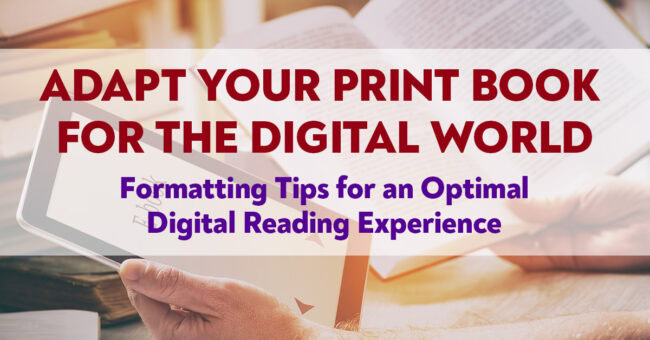A couple of weeks ago, I found myself exploring the banks of the Clark Fork River captivated by the scene unfolding at the water’s edge. The vibrant plant life was thriving in that transitional moment between fall and winter, adapting effortlessly with grand flair to these ever evolving seasonal shifts—much like stories, which can take on new forms while still preserving their beauty and essence.
Adaptability is one of the most remarkable qualities of a story—it can shape itself to fit any medium, from a beautifully printed hardcover to the screen of an e-reader. But embracing this adaptability often means rethinking how your book works in its new digital form.
When formatting an ebook, it’s essential to prioritize user experience. While it might feel tempting to replicate your print book exactly, digital reading comes with unique challenges. Wide elements like tables and charts, for example, often don’t translate well to smaller screens. Instead, consider reworking them into simpler, reflowable formats that are easy to read and interact with. This isn’t a compromise—it’s an opportunity to enhance how readers engage with your content.

6 ways to Elevate Your eBook Design
- Start with Essentials Up Front
Your ebook should immediately inform readers where they are with a clear title page and concise copyright details. This ensures a polished, professional impression from the first screen. - Use a Clickable Table of Contents
An interactive ToC is a hallmark of a well-designed ebook. Readers can jump directly to chapters or sections with a tap, making their reading journey seamless and enjoyable. - Rework Wide Content
Tables, charts, and other wide elements don’t always work well on digital screens. Simplify them or break them into smaller, readable chunks. Reflowable text or images are easier for readers to navigate and keep their focus on your content, not struggling with layout issues. - Incorporate Interactive Features
Ebooks offer tools print can’t match. Add features like hyperlinks to external resources, embedded multimedia (such as audio or video), or pop-up definitions for complex terms. These elements can make your ebook more dynamic and valuable. - Refine Chapter Layouts and Enhance Readability
Begin each chapter on a new page and maintain consistent formatting for headings and subheadings. Use adequate spacing and section breaks to keep the narrative flowing. These small adjustments create a smoother and more enjoyable reading experience for your audience. - Leverage the Back Matter
The back matter is an incredible space for adding value and engaging readers: - Acknowledgments: Thank collaborators, editors, family, or supporters. This adds a personal touch.
- About the Author: Share your story and include links to your website, social media, or newsletter sign-up.
- Call-to-Action: Invite readers to leave a review, check out related books, or explore additional content.
- Sneak Peeks and Previews: Offer a teaser for your next book to entice readers to keep following your work.
- Interactive Links: Use links to drive traffic to resources, blogs, or even exclusive downloads.
Want More Tips for Your Self-Publishing Journey?
My newsletter is packed with helpful advice on book formatting, design, and digital publishing. It’s your personal resource for making your book stand out!
What’s Next?
With these steps, your ebook will not only look professional and inviting but also provide an engaging, intuitive experience for your readers. Thoughtful formatting goes beyond aesthetics—it’s a chance to enhance reader connection and open up new opportunities to share and market your work. Ready to take your ebook to the next level? Let’s talk about how I can help with adapting your print book for the digital world.
Help for Independent Presses
Book Design & Production
Have you written a nonfiction or fiction manuscript? After it has been professionally edited, I can design the interior pages and cover, plus guide you through the maze of book publishing and printing. To get started, contact me to discuss your project and my helpful guide for authors.

